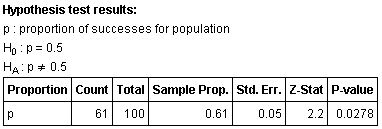

This is the default selection, so it's already done for us. Then down here under Perform, we're going to select the radio button for hypothesis test. So typically you're going to just take the column listed first as the first sample and the one that's listed next as the second sample. You need to select the samples and put them or tell StatCrunch where the data is actually going to be located. We actually do have actual data, so it's not a big problem.
#Find p value from level of signifigance stat crunch software#
That's just part of the way that the software was coded. So I can't provide summary statistics in order to do the test I have to have actual data. Notice with the paired sample option, I don't have the ability to do the test with anything but actual data. In the options window, I’m going to tell StatCrunch where to find my data. I’m going to resize this window so we can see more what's going on.Īnd now in StatCrunch, I'm gonna go to Stat –> T Stats –> Paired. I click on this icon so I can dump the data into StatCrunch. To do this, I'm gonna let StatCrunch do the heavy lifting for me. The next part asks us to identify the test statistic. That means we have a two-sided test, and this is going to be, therefore, not equal to (again, the same value) zero. And if you're on either side, there's some difference there. It doesn't matter which side you're on it's just one or the other. So it could be that the female is greater than the male, or the female is less than the male. The claim here is that there's a difference between female attribute ratings and male attribute ratings, so there's some difference. The alternative hypothesis - let's see if we can match the claim. And when you're looking at differences, typically the value that you're looking at is zero. Here we're actually looking at matched pair mean differences. The null hypotheses is by definition a statement of equality, so it will always be that the parameter is equal to some value. This is our population parameter for our hypotheses. For matched pair means, the parameter that we look at is the difference from the population mean, so we identify that with use of d (subscript). OK, this first part of a problem is asking us to identify the null and alternative hypotheses.


 0 kommentar(er)
0 kommentar(er)
